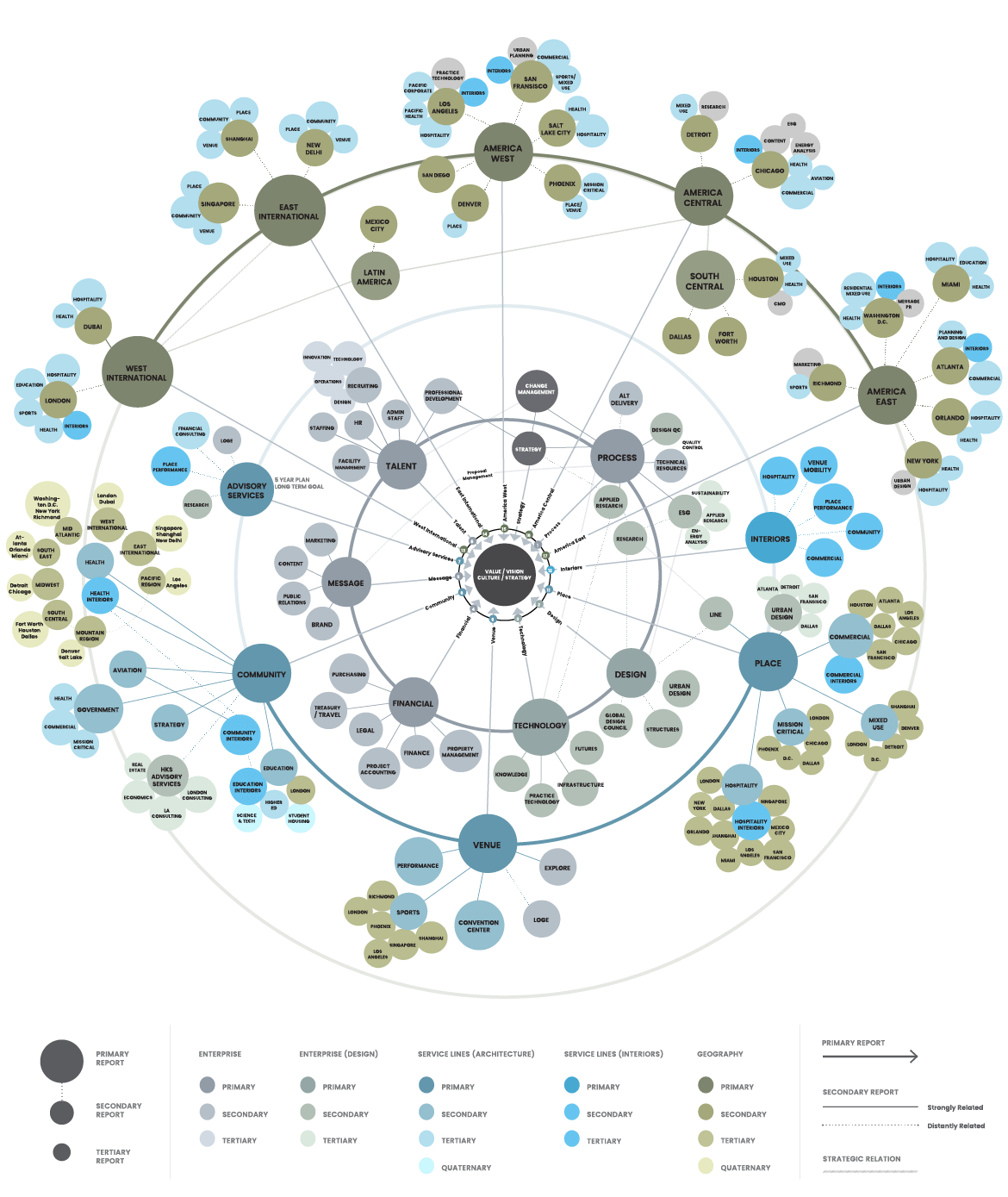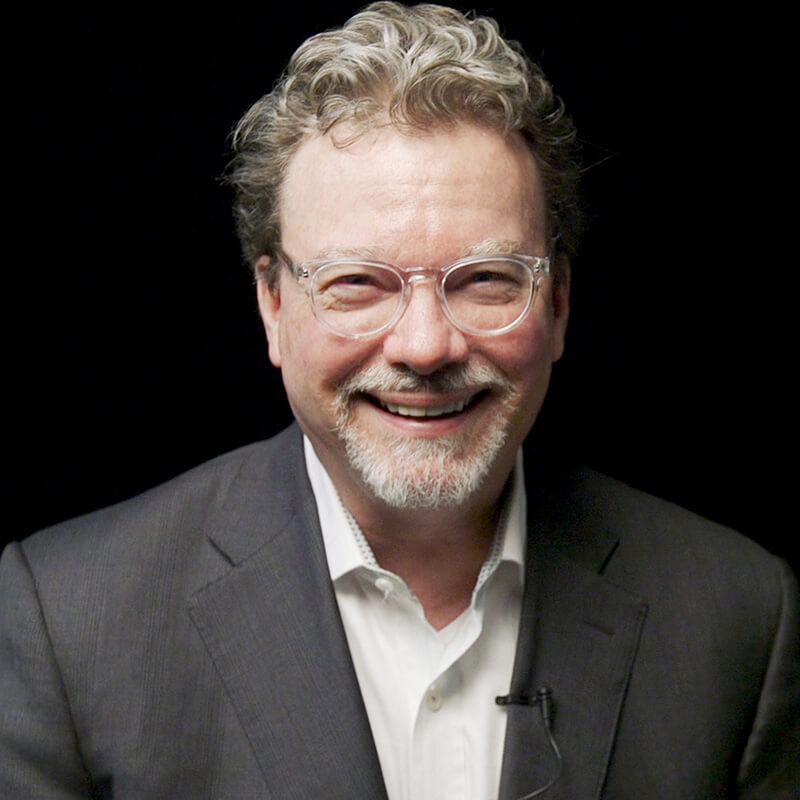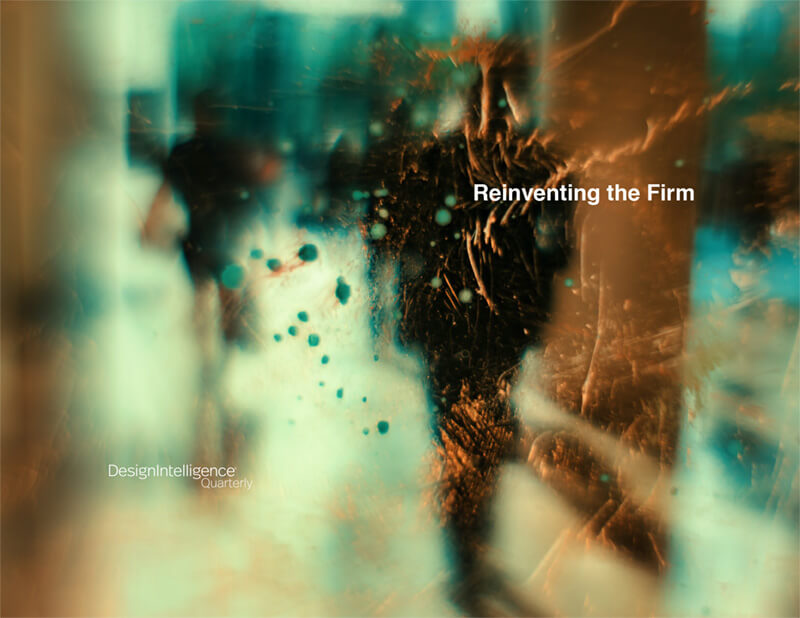Reinventing the Firm
by Dan Noble
President, CEO, HKS
October 13, 2020
Dan Noble reflects on HKS’s firm transformation using a values-based approach. An inside look.
DI: You have had time for reflection during the COVID sheltering in place and working from home period. What have you been thinking about — personally, for your firm, and the industry?
DN: This time has been valuable for reflection. Although we are quite busy, my schedule has been more predictable and stable these past months. That’s given me time to think, strategize, and determine what is important in this phase of my life — for me, as well as for our firm. I stumbled into a balance that has enriched my relationships and connections to many facets of life, personal and business.
My outlook is positive. Things are never as bad as they seem, nor as good. We are in a time of accelerated growth in innovation, technology, and focused, quality thinking. Good things always come out of these trying moments when we’re grinding away with purpose. We will take these lessons into the future to improve lives and do good. I believe we’ll look back at this time as one where we experienced a quantum leap in the quality of our lives. It may not feel that way while we are immersed in it, but time and perspective will be the barometers.
DI: Your firm recently completed a strategic refocusing — a reinvention of sorts. It seems prophetic that you accomplished this just before the arrival of COVID-19, and simultaneous economic, racial, and political crises. Are you a shaman, or was it a case of good timing and fortune? How did the process come about? How long did it take? Who did it involve? And how would you score it on the “pain index” on a scale from 1 to 10?
DN: Mostly good timing and good fortune. I’ve been in this industry long enough to expect constant cyclical fluctuation. After such a prolonged expansion, we knew we were due for a down-cycle. We had been on a ten-year run and felt like we were on borrowed time. That compelled us to reimagine our strategy and look for ways to continue to evolve — possibly even re-invent ourselves. We felt a change was afoot, but honestly, I don’t think anyone could have anticipated what we’ve experienced this year.
We started the process in the winter of 2017. I had met Dave Gilmore a year earlier, and we were kindred spirits in philosophy, ethics, strategy, and friendship. We hired D.I. and Dave to work with us to understand who we were and who we wanted to be before we jumped into planning. That’s something all firms should consider. That self-reflection and imagining forced us to look at every aspect of our business, from how we were structured, to how we invested our resources, to our people strategy.
We better defined our values, developed our mission and strategy, streamlined our business structure, created accountability and role clarity, and formally invested in a powerful Environment and Social Governance (ESG) strategy. Last year we created a Director of Justice, Equity, Diversity and Inclusion (JEDI) position. We put our money where our mouth is by investing in these things – and it all fell into place to put us into a managed position to deal with the crises that presented themselves this year.
We are experiencing a punctuated equilibrium in our society – a sudden, intense period of change in an otherwise stable world. Revolutionary vs. evolutionary change. I’m grateful we had already put in the hard work to reposition ourselves — not only to survive but to thrive during such a time. To use a sports analogy, we let the game come to us.
We started with a small group of leaders talking about our core values and expanded that to meet with all sector and regional leaders in a series of work sessions. Ultimately, to all shareholders. Dave was instrumental in guiding us through this process. It took over a year to complete and coordinate all the content of the work sessions and nearly another year to test and put the structure in place.
Two years later, we are still learning.
On a scale of 1-10, it was probably a solid 7 – some days a hard 8. Change is difficult. For some, the biggest pain point was holding our existing structure and strongly held beliefs too tightly. We needed to loosen up our thinking and let go of our egos. In that uncomfortable space we allowed ourselves to imagine what could be. We realized we had been operating in silos, and we didn’t have some of the business rigor and intention we needed to continue to grow and prosper. Formalizing the Plan was just the beginning of the story. The necessary change enablement strategy that followed was just as important – if not more so. Changing legacy patterns of entrenched behavior takes time, patience, and constant strategic communication.

DI: Can you describe the transformation to build a foundation for readers? What was the firm before, and what is it now? Structurally, culturally, and in every other way.
DN: In 1939, our founder Harwood K. Smith created a firm that felt like family and became known for technical excellence, professional management, and outstanding client service. Over the years, many spent their entire career at HKS. If there is one aspect we didn’t want to lose, it’s the family culture our firm was built upon, and the continuity through generations.
So, when we kicked-off our visioning sessions, we started by defining our values. Our values aren’t just our business — they’re personal. Relationships, Character, Purpose. These values make us who we are as connected humans and define our firm.

We clarified our vision: “To be the most influential firm in our industry.” Beyond the buildings, we want to impact and influence the people who engage with the space — furthering not only our firm, but the industry. We want to create the kind of architecture that heals communities, brings people together, enhances their lives, solves real problems, and is beautiful too. We want to expand our expertise and renown in technical delivery and make our mark as a firm globally known for our outcome-driven, high quality design.
For our organizational structure, we built on longstanding logic. We had always been a sector-driven, region-executed firm. Our new plan simply clarified the relationships and drivers between our sectors and regions. By clarifying roles and decision-making responsibilities, we gained accountability and agility in determining our market strategy and in which marketplaces we wanted to invest. We mapped a more robust, equitable, and diverse leadership structure and changed our culture to be more collaborative and forward-thinking.
We also simplified our reporting structure. In the past I had over 80 direct reports. By shifting and distributing the leadership responsibility, I have fewer than 15 now, but I’ve also empowered others to grow and assume leadership roles to leverage our talent more effectively. I still have an open door, but now I share in the accountability and mentoring with a larger team of leaders.
DI: Why did you decide to undergo such a radical transformation? Your firm had been successful and had decades of longevity. What was wrong with the status quo, or with continued incremental change and evolution? What were the primary factors that drove you to reinvent the firm?
DN: As an 80-year-old firm, we were hovering in the territory of becoming commoditized – which we feared would lead to stagnant opportunities at best and irrelevance at worst. We could no longer afford to call ourselves an “architecture, interior & urban design” firm. We had to organize and resource ourselves to become a problem-solving technology firm that provides design services. That’s not just semantics. It’s a seismic shift in strategy. We sought to become a “solutions” firm that influences our industry to create a better world. As designers, we are uniquely equipped to optimize urban design, density, socialization – even pandemic control. Our voices and expertise can generate powerful influence in every one of our practice areas – from community and health groups to schools and city planning.
DI: What initiated it? Were there key indicators, feelings, hunches — or data that prompted it? Client, partner or associate feedback? Or market and contextual awareness? How did you know it was time?
DN: The recession of 2009 profoundly impacted our firm. Having lived through that, I wanted to understand how we could be better prepared for future contractions in the economy. I love the quote by W. Edwards Deming: “It is not necessary to change; survival is not mandatory.” Especially now, agility is THE indicator of a firm’s ability not just to survive but to thrive. How quickly and nimbly can we adjust to the needs of our clients and communities before our competitors do? This dynamic will only be amplified with each passing year.
But it’s important to know we did not deny or reject our history to reinvent the firm. We didn’t throw the baby out with the bath water, so to speak. We took the best things about our history and improved them and took a hard look at what we wanted to be in the future and figured out a transition plan to get there.
DI: Since your firm reinvention two years ago, in the current context, how did you do? Certainly, you couldn’t have imagined any of what is happening now. Are your new systems serving you well? What are the greatest successes? Specific services, forms, systems, or concepts that have been game changers? Any that didn’t work as well that need to be refined? Has the firm’s new strategy positioned you to better cope with COVID and the other crises we are facing? How has COVID affected those strategies?

DN: We are certainly more agile than we were two years ago. Change is like a muscle. If you don’t exercise and flex it, strength atrophies. If you exercise consistently, you are building muscle mass you can leverage when you need it. Our endurance and comfort with change has been enhanced over the last two years of focused effort.
The cross-practice agility and creativity we demonstrated in tackling some tough assignments in record time to deal with the surge of COVID cases is one great illustration of how our culture has changed and strengthened. We worked with the Army Corps of Engineers to transform convention centers and decommission hospital spaces into COVID treatment spaces. And, we did it in a matter of days, not weeks or months.
Our hospitality, health, and advisory leaders came together to define ways hotels could be healthier and adaptable for other uses. We made an acquisition into the senior living or later living building type, because we felt that industry was ripe for re-invention and meshed with our expertise in health, hospitality, mixed use, research, and sports.
We wrote research pieces on loneliness/isolation, mental health, and human behavior to understand how isolation affects our work relationships and personal lives. We redefined office space design to create more effective teams and a safer hospitality space, expanding beyond physical environment to digital. We formalized our Advisory services – not just micro, but macro solutions. Rather than merely physical environment, we looked at the implications of how we use space more effectively to rework the client’s processes.
Many examples of cross-practice thinking wouldn’t have happened in the same way before we implemented the plan. COVID played a role in moving us to a virtual environment, which enhanced our communication and collaboration. The plan also exposed some gaps in leadership and resources, and we have been addressing those to strengthen those capabilities.
We also realized we didn’t have a structure in place to measure performance at the level the plan required. This year we invested in a performance management system that allows us to create and track target Objectives and Key Results (OKRs) at company, practice, and individual levels. This not only helps us measure specific objectives, but also gives us a connected, big-picture vantage of our priorities and investments. In short, we are absolutely better positioned and poised to cope in times like these. Our clarified roles and responsibilities help us make decisions quicker. We’re better informed. We don’t waste time wondering who the key stakeholders are – we know them and are able to spend more quality time focused on the challenge at hand.

It has also made us smarter in prioritizing our investments. We use the strategic plan as our guide for making difficult decisions. Honestly, we surprised ourselves with how many “impossible” disruptions we were able to navigate. For example, moving an international company of 1,300 to a purely remote working environment in 3 days without skipping a beat, and almost immediately advising our healthcare clients on how to radically transform their operations in the face of COVID.
DI: Has COVID necessitated any further organizational shifts? Service line or locational shifts?
DN: Not significantly. We’ve moved people around between practices to balance the need. Hospitality, sports, and commercial don’t need that help. Health, education, mission critical, research, and advisory services did. Shanghai, Singapore and Dallas remain busy, so we’ve shifted resources to accommodate their needs.
DI: You have a strong consulting advisory services practice. Has COVID affected that, or impacted its location and centrality?
DN: Yes, they are very busy and in demand. We’ve added personnel in London, Dallas, Austin, and California. Both our research and advisory teams have been working overtime to provide service and guidance to our clients and communities.
DI: What do see as you look forward? Your contemplations about the firm, the industry, and the world? How are these uncertain times shaping your view of the future?
DN: I’m an optimist. I see great things coming out of this time of sacrifice. I believe you make incredible strides when times are challenging. Necessity really is the mother of invention. I’ve asked our leaders, “Do you want to be the authors of your future or the victims of your circumstances?” I believe, as designers and problem solvers we can help define a better future our communities are clamoring for.
DI: What does the HKS life cycle curve look like going forward?
DN: We will always have peaks and troughs – that’s normal in a business. But the behavior and accountability we have in place now will allow us to run the business while intentionally looking ahead.
If we’re structurally sound and appropriately diversified, we can stay ahead of the innovation curve using novel ways to support our clients. We believe the work we have been doing will yield a stronger, more equitable firm — one well positioned to meet the challenges of the future. We’re excited to explore what is next.
DI: When will you be due for your next reinvention? Will it be just an oil change or a whole new vehicle? Or maybe abandoning vehicles and inventing a new kind of transport?
DN: As a learning organization we are constantly assessing, iterating, learning, and retooling. It’s funny, we look at our business in terms of the machine and the fuel. Our goal is to constantly refine and optimize how our machine (our people, governance, structures, processes, etc.) functions, while ensuring a steady supply of the right, high octane fuel (our people, client relationships, projects, revenue, strategic diversification, etc.).
With a balanced focus on these two critical aspects, we don’t have to completely reinvent ourselves. Instead, we can simply create the most sustained, optimized performance possible.
DI: What can you share about the experience and process of firm reinvention with others who haven’t completed their own? Any advice for how to go about it?
DN: Large-scale transformation is not for the faint of heart. You need real commitment and buy-in — especially at the highest levels of leadership. You have to know it’s a marathon, not a sprint. It’s an exercise in sequential layering. Some changes can’t be made until others are solidified. For example, you must have a functional organization structure before you can make more granular changes at the practice level.
You also need an appetite for extreme transparency and trust. It’s not always comfortable – but without it, your communication and change efforts will get waylaid before they begin.
So, with some endurance, grit, honestly, humility, trust in your fellow leaders — and a big dose of levity — any kind of transformation is possible.
Dan Noble, FAIA, FACHA, LEED AP, is President and CEO at HKS. An architect, Dan leads the strategy and development of a global design firm. Under his leadership, the firm has won numerous design awards from organizations such as the World Architecture Festival and Fast Company. Dan values character, purpose, and relationships, and instills these values into the firm’s culture.


